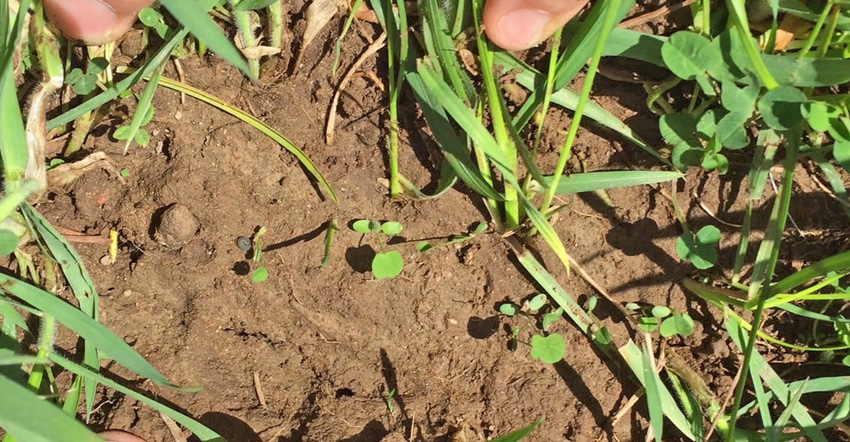February 5, 2018

By Gene Schriefer
I like to think of myself as a planner, but sometimes life happens and I forget about the thinking ahead part.
With pasture renovation, you should be planning and thinking ahead. But when you should be thinking and planning, you’re also trying to wrap up a cropping year. The fact is, everyone is busy.
Pasture renovation can be partial or a complete renovation. With a partial renovation, you’re attempting to not start over, but to enhance what is already growing in the pasture.
Completely renovating a pasture ideally begins in the fall when you can terminate the forage. By spring, once the frost is out, you can no-till seed into the killed sod at an eighth of an inch, assuming you want a cool-season mixture. If you did not kill the sod in the fall, you need to wait until temperatures are warm enough for the plants to be actively growing before you can terminate. Spring termination sets you back a month or more.
I get excited when the new grass seed catalogs come out. I like looking for what’s new and improved, and then trying to find these “better” varieties in some Midwest universities’ forage testing trials to confirm their superiority. As you review trials, you should notice there can be 2 to 6 tons of variation between some varieties.
My corn- and bean-growing neighbors routinely review yield plot data from university trials, as well. My guess is, if they noticed a variety yielding 50% less than another, they may not pick that one. Yet producers with pasture often ignore available information, call the co-op and ask them to send out some information, and then whatever is lying around is seeded. If the co-op doesn’t carry the varieties you’re interested it, keep looking. Are you really willing to give up that much yield and settle for what your supplier has on hand? Look for a new — and more knowledgeable — supplier. If you do choose to settle, please don’t whine about low-production pastures.
Before they renovate, I encourage folks to think about why they need or want to renovate a pasture. Why do you have what you have? Is it your management? Is there a fertility issue? There’s often an underlying cause — an unproductive pasture is a result, a symptom. You can renovate, but over time, if you change nothing else, the new pasture will revert to its current species composition. There may be enough of an improvement in yield and production before it reverts to cover the cost of the renovation, but then again, there might not. Soil tests offer cheap information to enable you to make a better decision. It’s economically foolish not to take advantage of them.
Use quality seed
You want to look for quality seed with high germination rates. In a partial renovation, ideally you will have weakened the stand the fall prior with close, tight grazing. Most pasture in Wisconsin fits this description already. Clover is the most successful species you can interseed; red and white clovers are more aggressive as seedlings and able to compete with the existing sward. Grasses are much slower and less aggressive from seeds, so generally do not interseed these. A possible exception is perennial ryegrass, but this is a short-rotation grass that may only survive one or two seasons.
In a complete renovation, we need to consider species: a single species, a little diversity or a highly diverse mix. For pasture, the more diverse the mixture, the more even the production will be over the entire grazing season. Some species grow better at different times of the year or under different heat and moisture conditions. As a minimum, I’d suggest thinking about three or four species of grass, two or three legumes, and possibly a forb. This is not a highly complex mix.
To rules there are always exceptions, and the exception here is endophyte-free tall fescue. Don’t put tall fescue in a mix — this one should be planted alone. While high-yielding and persistent, it is less palatable than all other species, resulting in overgrazing the other species in the mix and leaving behind the tall fescue, which will quickly become the dominant forage.
The goal for a seeding rate is in the 50-to-75-plants-per-square-foot range. As you seed higher rates, there is increasing competition among the seedlings. It looks great, but by the end of the season, mortality will be excessively high. You’ll end up with 50 to 70 plants anyway, and there will be no difference in yield. A handy seeding rate calculator is available.
In summary, soil test, review and select improved varieties, seed as early as possible, aim for a final seeding goal of 50 to 70 plants per square foot, and ensure good seed-to-soil contact, just not too deep.
Schriefer is the Extension ag educator in Iowa County, Wis. This column is provided by the University of Wisconsin Extension’s Wisconsin Beef Information Center. Learn more at fyi.uwex.edu/wbic.
You May Also Like




